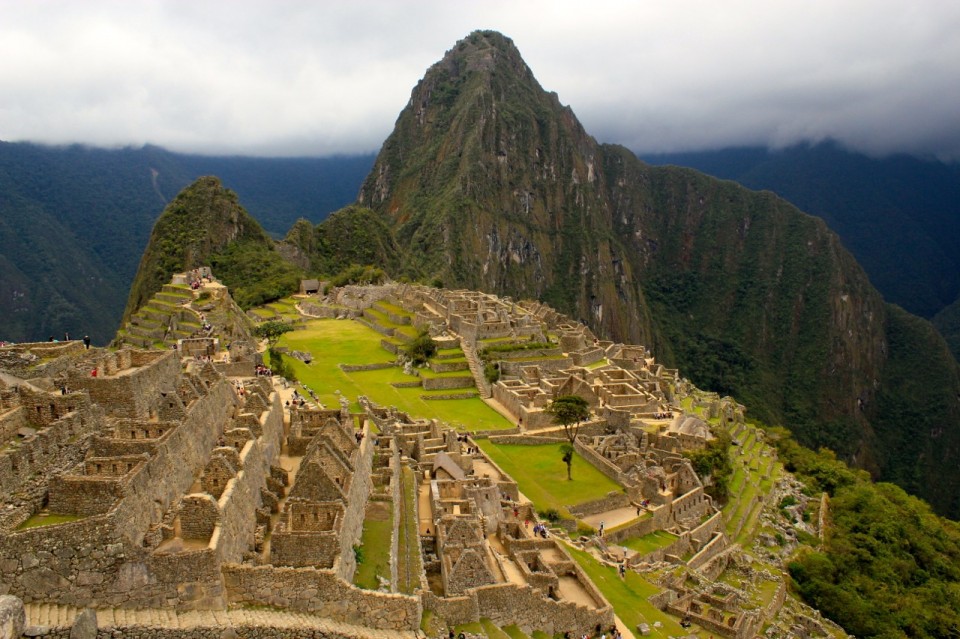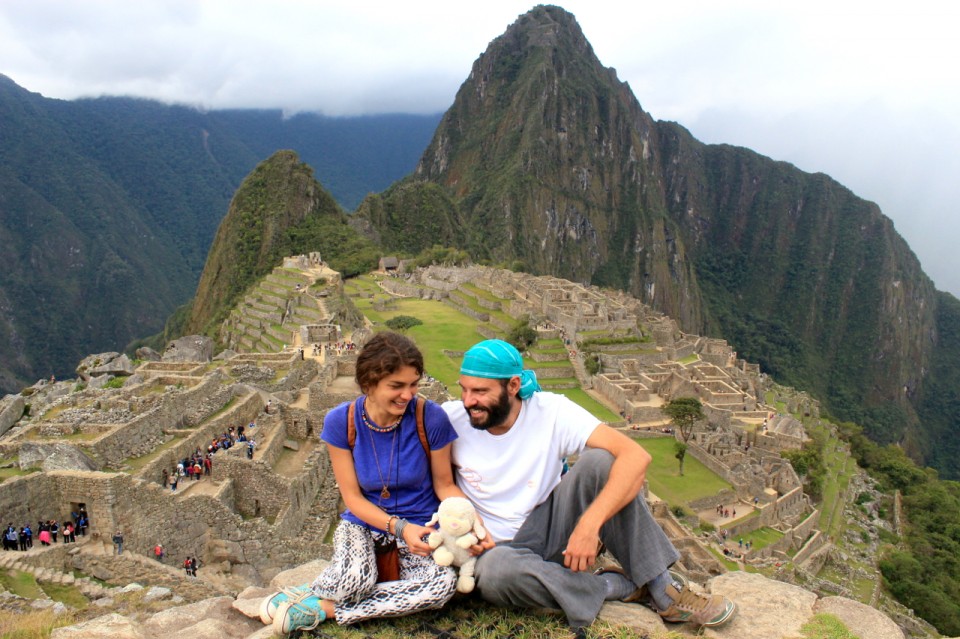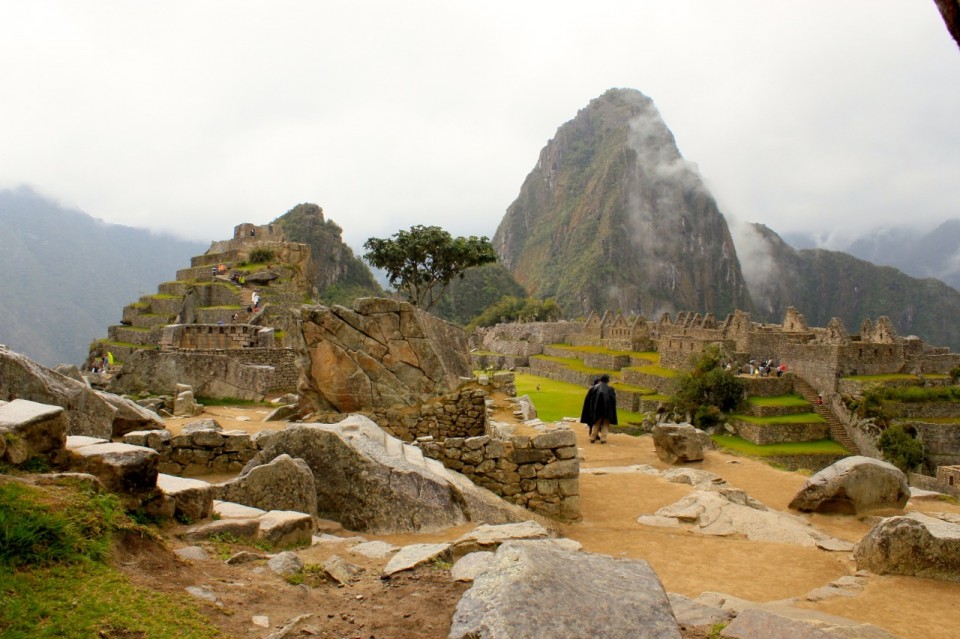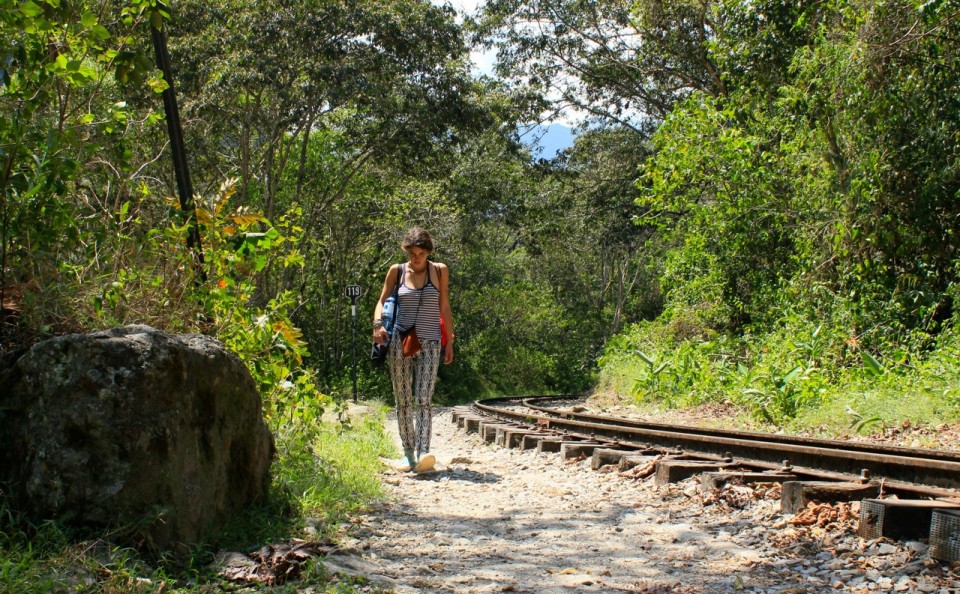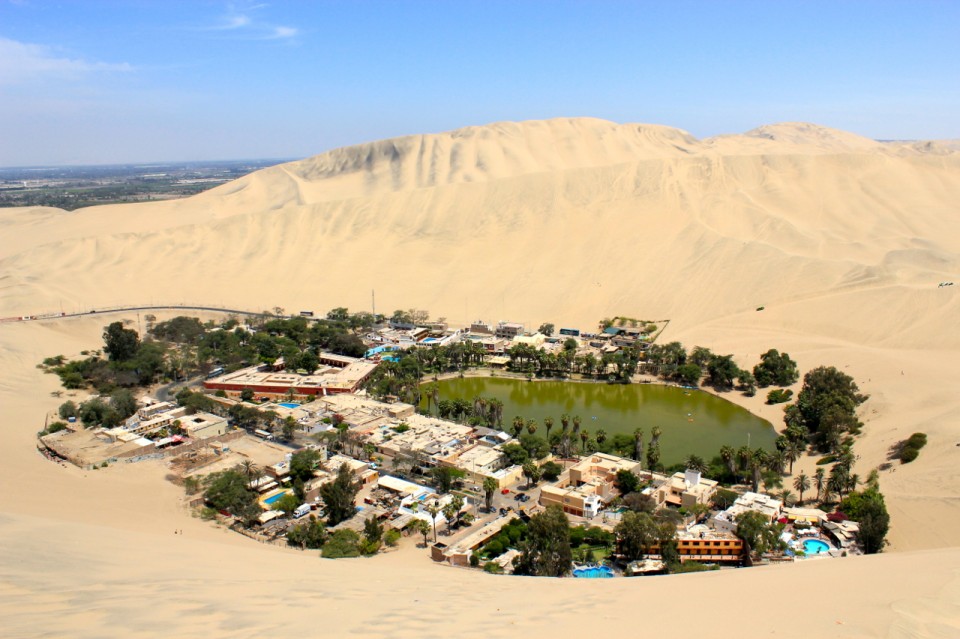Feeling dead tired, but proud to have reached our goal alive after having walked for the whole night next to the railroad, accompanied by the angry dogs, we were taking a walk around Aguas Caliente looking for a place to stay.
We knew we were probably in the most expensive town in Peru which you had to visit if you wanted to go to Machu Picchu – the most popular tourist destination in this part of the world. It was the last stop before Machu Picchu so when there is no other option for the tourists, the owners of the restaurants and hotels knew perfectly what to do – raise the prices. We browsed around the shops and noticed that the prices were the double than the ones in Cusco which were also very high; the hotels were either full or very expensive and by the menus we saw in the restaurants we realized that, during our stay here, we’d have to live off the basic products or be hungry.
With the last forces we had we found a hotel at a good price – while we tried to negotiate the price we made use of the fact that it was already very late and we also told them what we’d had to go through to get there. We took a (cold) shower and went out to get something to eat.
We stopped at the first restaurant we ran into to check out the prices. Too expensive. We stopped at the second one – the same story. However, while we were looking at the menu four people that were sitting at the table next to us got up and left. They left seven pieces of pizza behind them: on each plate there was a small piece. I took a look at the price of the pizza not being able to understand how they could leave so much food on their plates which was very expensive. I looked around me and took a look at Maria.
Shall we? – I asked her.
Yes. – she answered shortly.
As quickly as possible we grabbed the remaining untouched pieces of pizza, threw a smile at the surprised people sitting around us that were looking at us and took off.
Both Maria and I had already done that kind of things in the past, just not together and not in Peru. We started laughing as we were stuffing our mouths with food – we were so proud. Not only did we stop them from wasting all that food, but we were also fed very well and saved our precious money. Everyone won!
We took a stroll down the picturesque town which, only a couple of years before, had been a small village with ten houses which was transformed into a complex of hotels, restaurants and tourist agencies and all those things that hadn’t been there before. On one hand, I could understand it: all those tourists coming from all over the world to see one of the most amazing sights in the world had to eat somewhere. Still, on the other hand, you couldn’t help but feel sorry for everything that was being subjected to powerful money of tourism.
We slept the whole night and the following day we decided to spend another day in Aguas Caliente before moving on to Machu Picchu. The reason: the consequences of the adventure of the night before – I had a couple of blisters on my feet and Maria was limping a bit; she thought that she may have strained the ligaments of her right ankle. It was difficult even to walk, let alone to limb for two hours. Above all, it was cloudy and nobody wants to arrive to Machu Picchu and see nothing but the clouds.
The time we had we used it for exploring the history of the place we’d visit.
Machu Picchu – Lost City of the Incas
It is generally believed that Machu Picchu (translated from the local language it means – old peak, old mountain) was built in the 15th century by the tribe of Incas ruled by Parachuti. A century later it was abandoned during the Spanish conquest and it was “re-discovered” in the 20th century by the American historian Hiram Bingham.
In fact, he did not even discover it. Machu Picchu was known to the local people who lived there, farmed the land, and took the kettle to the pastures. They simply did not pay much attention to “some ruins on the top of the mountain”. Only when the Westerns arrived did they notice the importance of the entire complex that was left untouched after the Spanish conquest so it was an excellent example of the lifestyle of a lost civilization.
Because of that importance and the fact that the sight looked really amazing on the photos, Machu Pichu became one of the most famous tourist attractions and it was restored in order to let people know what it looked like back in the days; also, it is the part of UNESCO cultural heritage.
We made use of our day off to find the cheapest place to eat and we found it, just like in others towns in Peru – on the market. Not only did the food was the cheapest it was truly local: you couldn’t find pizza, spaghetti or burritos there like you could find them in every restaurant as if someone walked around and copy-pasted the menus.
– Two student tickets, por favor – we asked from the man that was selling tickets for Machu Picchu giving him our ISIC cards. We knew that they had expired a couple of years before, but we hadn’t had any kind of problems with that before: so far we managed to get discount on our student card, on the monthly train ticket and once even on my year ticket for the NK Dinamo for the year 2007.
254 soles, por favor – he said calmly, giving us our cards back while charging us the full price of the ticket. Not only did we fail, but he didn’t even give us the chance to try to talk him into giving us the discount, to negotiate, to beg. We had never experienced being ignored and rejected like that.
Oh well, after all, we were going to Machu Picchu. We did feel a bit better after spending the money when we thought of it.
However, the costs didn’t end there: since we still didn’t feel like we could endure the climb all the way up, we decided to use the bus that would take us to the entrance to Machu Picchu. Besides that, it was quite late already so we didn’t want to take our chances and we wanted to make use of every minute once we’re there.
There was a river of tourists at the bus station and another river at the entrance to Machu Picchu, but once we were in we didn’t care about anything: prices, tourists, and the state of our feet – nothing was important anymore.
Despite the fact that we had already seen the sight in front of so many times on photos, in documentaries and films we were still taken aback by its magnificent beauty.
Speechless.
We took a stroll around the entire complex, took shelter in a cave when it started to rain, hang around with the llamas and enjoyed ourselves on a place that wasn’t a typical tourist route.
All in all, as a professional writer would say, it was nice.
After a few hours of enjoying ourselves it was time to get back to Aguas Caliente. We were determined not to pay for the bus ticket to get down the mountain so we decided to go down on foot. Slowly. It was a bit painful, but we really enjoyed the beautiful nature, fresh air, the fact that there were no tourists and we did save a bunch of money.
We slept the whole night and headed back to Cusco.
Since we got to Aguas Caliente from Ollantaytambo on foot we made the decision to follow the same pattern on our way back – two hours of walking by the railroad, in the opposite direction, to the Hidroelectra.
We had to change three vans to get back to Cusco.
Our road trip to Machu Picchu was the end of a chapter of our Peruvian adventure. We wanted to go to the sea, we went to the sea. We wanted to climb to the Andes, we did that. We wanted to go to the jungle, we went there. We wanted to climb on Machu Picchu, we visited it.
Now what?
We didn’t have the slightest idea. However, we did know that we were tired. We were tired of the journey, of constantly changing places, of packing and unpacking, of all those kilometres. We needed to settle down a bit.
And we could change the country. We had been in the same country for more than three months. We looked at the map and chose our next destination – Chile. Bolivia was also very interesting, but the rainy season was about to start and the roads there were the same as the ones we had to take on our way through the Andes – you could get yourself killed.
Also, from Cusco we were moving southward so we tried to find online some good places to volunteer. We needed a stationary, a place where we would feel like at home and where we wouldn’t have to play for accommodation and food; we were already way over our budget with having visited all the parts of Peru, no matter how hard we tried to save some money by hitchhiking, avoiding eating in the restaurants and visiting the souvenir shops, etc.
We came across a number of interesting options: from volunteering on permaculture farms, working in a hotel, guarding a motel on the coast, to working on an estate where we would have to stay for a year and have our own house, a car and a small salary. We sent e-mails to everyone and waited for the replies.
In the meanwhile, we arrived to Chile.
The first thing we noticed upon our arrival was the temperature. Even though we were on the sea the temperature wasn’t much warmer than Cusco which was at 3,400 meters of altitude. The second thing were the prices. Compared to Peru the price of accommodation was too expensive. The cheapest accommodation we found was pretty much the same as the most expensive one during our stay in Peru. What soon followed was the third shock. When we went to the market we noticed that the prices were double when compared to those in Peru. The only positive thing was that the price of wine was three times cheaper than those in Peru.
We didn’t like Chile.
Arica is, in fact, the cheapest town in Chile – our host informed us when we asked him if all the town in Chile were that expensive.
Wonderful.
What are we going to do? – I asked Maria during our first night in the new country while we were treating ourselves to great red wine.
I have no idea – she answered – We still didn’t receive any reply about volunteering, we aren’t going to Bolivia where everything is cheap due to the weather conditions and if we stay here for weeks waiting for a reply we’ll bankrupt.
Okay then, let’s go back to Peru – we agreed.
After three months in Peru and one day in Chile we were going back to Peru.
We stuffed our back packs with a couple of bottles of wine, crossed the border and discussed where we’d be going next.
What is the place where we had the most beautiful time? – we asked ourselves. We knew the answer – while we were volunteering for three weeks in Mancora and during our stay in the jungle with our Croatian friends and the shaman. Since in the jungle, just like in Bolivia, the rainy season just started we made the decision – we were going to Mancora. And there were only 2,5000 kilometres to Mancora.
We headed off slowly, visited a couple of towns that were on our way and sent a few requests to volunteer on the north of Peru, hoping that we would be able to stay at the same place where we started with our Peruvian adventure – in the beautiful KiChic hotel, in Mancora.
And then, one morning, purely by accident, we ended up in a real oasis – Huacachina!
GALLERY – PERU.
